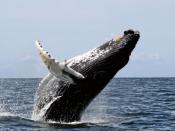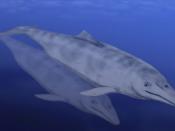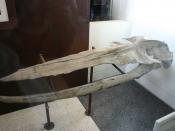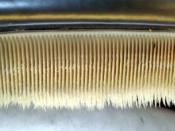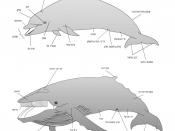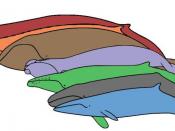The baleen whales, also called whalebone whales or great whales, form the Mysticeti, one of two suborders of the Cetacea (whales, dolphins, and porpoises). Baleen whales are characterized by having baleen plates for filtering food from water, rather than having teeth. This distinguishes them from the other suborder of cetaceans, the toothed whales or Odontoceti. Living Mysticeti species have teeth only during the embryonal phase. Fossil Mysticeti had teeth before baleen evolved.
The suborder contains four families and fourteen species. A list of species can be found below and at the Cetacea article. The scientific name derives from the Greek word mystidos, which means "unknowable".
Baleen whales are the largest animals on earth, yet they feed on some of the smallest animals in the ocean. There are 12 baleen whale species divided into 4 families: right, pygmy right, gray and rorqual whales.
Right whales were called the "right" whales to catch by early hunters because they are large, swim slowly, have long baleen plates, contain lots of oil, and float when killed.
Right whales do not have dorsal fins or throat grooves. The taxonomy of this family is rather confusing, but currently there are three species of right whales: the Northern right whale, Southern right whale, and bowhead whale. The pygmy right is in a separate family although it shares similar characteristics to right whales.
Gray whales have their own taxonomic family, genus, and species. They are the most coastal of the baleen whales and are often found within a few miles of shore. Each year gray whales migrate between their summer feeding grounds in the Bering, Chukchi, and Beaufort Seas to their winter breeding grounds off Baja California, Mexico. This is one of the longest migrations by a mammal species.
Gray whales are gray in color and their skin is encrusted with barnacles and a unique species of small crustaceans known as "whale lice." They have 2-3 short throat grooves and instead of a dorsal fin they have a low dorsal hump followed by 6-12 "knuckles" or bumps. Whalers used to call gray whales "devil fish" because of their aggressive response to being hunted.
Rorqual whales are relatively streamlined in appearance and have pointed heads and small pointed fins. They can be distinguished from other whales by many (25-90) deep groves along their throats that expand when they feed. There are 8 species of rorqual whales: the humpback whale, fin whale, Bryde's whale, blue whale, northern minke, antarctic minke, Eden's ("small-type") whale.
Early baleen whales first appeared as far back as Early Oligocene, or perhaps the latest Eocene (39-29 million years ago; E.g. Llanocetus). Early baleen whales possessed teeth inherited from their ancestors, as opposed to baleen, in modern species. The Oligocene species Aetiocetus cotylalveus is considered the evolutionary link between toothed and baleen whales. It was discovered by renowned fossil collector Douglas Emlong in 1964 near Seal Rock State Recreation Site, Oregon in a sandstone formation. In the early 1990s, the species Janjucetus hunderi was discovered in Victoria, Australia by a surfer and was described in 2006 by E. M. G. Fitzgerald. Janjucetus was a baleen whale with sharp teeth that hunted fish and squid as well as larger prey, potentially including sharks and dolphin-like cetaceans. These fossils hint that early baleen whales were predatory and eventually evolved into the gentler, toothless whales known today. A recent study identified palatal foramina (bony impressions of blood vessels that 'feed' the baleen racks) in the palate of a toothed mysticete, Aetiocetus weltoni. The scientists involved indicated that this discovery implies that this whale possessed both teeth and baleen, and serves as an intermediate adaptive role between primitive toothed mysticetes and more advanced toothless mysticetes. The first baleen-bearing, toothless baleen whales (such as Eomysticetus, and Micromysticetus)appeared in the late Oligocene. Early baleen whales probably could not echolocate; no anatomical evidence preserved in the skulls and ear regions of any fossil baleen whales show any of the adaptations associated with echolocation as in 'toothed whales' (Odontoceti).
Bibliography:http://virtualology.com/aquatichall/baleenwhales.com/http://en.wikipedia.org/wiki/Baleen_whalehttp://www.seaworld.org/infobooks/baleen/home.html
